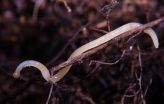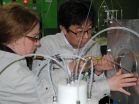(Press-News.org) Imagine you are a species which over thousands of years has adapted to the arctic cold, and then you get exposed to a substance that makes the cold dangerous for you.
This is happening to the small white worm Enchytraeus albidus, and the cold provoking substance, called nonylphenol, comes from the use of certain detergents, pesticides and cosmetics.
Nonylphenol is suspected of being a endocrine disruptor, but when entering the worm it has another dangerous effect: It inhibits the worm's ability to protect the cells in its body from cold damage.
Enchytraeus albidus is a species of earthworms, which can be found from the Arctic to temperate regions of Europe. It is a so called ectotherm; an animal whose body temperature closely follows the temperature of the environment in which it lives. It is grown as feed for some aquarium fish.
Liquid Membranes and Artificial
Cell membranes are mainly composed of certain lipids – phospholipids. When ectothermal animals are exposed to cold, their cell membranes become stiff, just as butter does when you put it in the refrigerator. This is not good, because cell membrane must have some fluidity, so that for example transport proteins can pump molecules and ions into and out of the cells in the right way. Conversely, heat can also be a problem, because it makes cell membrances too fluid.
Fortunately, Enchytraeus albidus - and many other ectothermal animals - can adjust the fluidity of membranes by altering the lipid composition of their cell membranes.
Now it turns out that nonylphenol makes the worm's cell membranes more stiff, so it is harder for the worm to tolerate the cold. The researchers from Aarhus University, University of Southern Denmark and Roskilde University have demonstrated this by experiments with artificial cell membranes.
Realistic Cocktail
The researchers' work can pave the way for more accurate assessments of how pollutants affect ecosystems – a field called ecotoxicology.
"Usually, when you make ecotoxicological risk assessments for hazardous substances, you make experiments with different organisms at room temperature, or at the optimal temperature for the organisms. But in nature, the organisms rarely have optimal conditions. They are stressed by high or low temperatures, drought or disease. This gives a risk of underestimating the real effect of substances in nature", explains research leader of the project, professor Martin Holmstrup from Aarhus University.
His research team has tested many different hazardous substances at low and high temperature or drought, and the researchers have seen synergies between the effects of such substances and for example low temperature.
"We found many instances where the two effects reinforce each other, and we set out to uncover the mechanism behind this cocktail effect. Now we have uncovered part of it, "says Martin Holmstrup.
Several Animals, Chemicals and Effects
So far, the scientists have revealed the mechanism of two pollutants, both lipophilic (meaning that they can be dissolved in fat) - namely nonylphenol and the tar substance phenanthrene.
As nonylphenol makes the membranes more stiff, the researchers see the opposite effect from phenanthrene. This substance makes the cell membranes more fluid and thus the worms more resistant to cold when occurring in the right concentration.
The same effects were observed in another organism, the tiny springtail (Folsomia candida; a kind of primitive insect). As opposed to the small earthworm this animal does not live in the Arctic.
How to Make a Cell Membrane
The scientists analyzed the two substances' effect on artificial cell membranes using methods developed at the Center for Biomembrane Physics at the University of Southern Denmark.
"We pulled all lipids out of the organism and created a mean membrane whose physical properties we could study. We chose to characterize the membranes elastic flexibility and express it in a single quantity, namely the bending rigidity. And we found that phenanthrene makes the mean membrane much more flexible both for the worm and the springtail, while nonylphenol makes the membranes more stiff", says John H. Ipsen, associate professor at the University of Southern Denmark.
Additionally, calorimetric measurements at Roskilde University have confirmed that the temperatures where a phase transition of the artificial membranes happens (i.e. solidification or melting), are affected by the two substances.
Close to Reality
In parallel, the researchers tested the two substances on worms and springtails by polluting the soil that the animals inhabitated in the laboratory, They measured both how their cold tolerance was affected under changing temperatures and the amount of the substances they had accumulated.
Martin Holmstrup from Aarhus University emphasizes that the experiments and measurements were carried out under circumstances are very close to reality, except for one point:
"We have used chemicals in concentrations higher than found in nature. We need further tests and investigations to find the influence of lower concentrations in nature. But now we know the mechanism", he concludes.
INFORMATION:
Photo: Enchytraeus albidus (på dansk: enkytræ) er en art af regnorme, som er udbredt fra arktis til de tempererede egne af Europa. Den avles også som foder til bl.a. akvariefisk. Foto: AU.
Contact
Professor Martin Holmstrup
Department of Bioscience
University of Aarhus
Email: mho@dmu.dk
Tel +45: 87158823
Cell + 45 30183152.
Associate Professor John Hjort Ipsen
Department of Physics, Chemistry and Pharmacy
University of Southern Denmark
Email: ipsen@memphys.sdu.dk
Tel: +45 65502560.
Ref: Lipophilic Contaminants Influence Cold Tolerance of Invertebrates through Changes in Cell Membrane Fluidity.
Environmental pollutants make worms susceptible to cold
2014-09-19
ELSE PRESS RELEASES FROM THIS DATE:
Quick-change materials break the silicon speed limit for computers
2014-09-19
The present size and speed limitations of computer processors and memory could be overcome by replacing silicon with 'phase-change materials' (PCMs), which are capable of reversibly switching between two structural phases with different electrical states – one crystalline and conducting and the other glassy and insulating – in billionths of a second.
Modelling and tests of PCM-based devices have shown that logic-processing operations can be performed in non-volatile memory cells using particular combinations of ultra-short voltage pulses, which is not possible with silicon-based ...
Milestone in chemical studies of superheavy elements
2014-09-19
An international collaboration led by research groups from Mainz and Darmstadt, Germany, has achieved the synthesis of a new class of chemical compounds for superheavy elements at the RIKEN Nishina Center for Accelerator-based Research (RNC) in Japan. For the first time, a chemical bond was established between a superheavy element – seaborgium (element 106) in the present study – and a carbon atom. Eighteen atoms of seaborgium were converted into seaborgium hexacarbonyl complexes, which include six carbon monoxide molecules bound to the seaborgium. Its gaseous properties ...
Technique to model infections shows why live vaccines may be most effective
2014-09-19
Vaccines against Salmonella that use a live, but weakened, form of the bacteria are more effective than those that use only dead fragments because of the particular way in which they stimulate the immune system, according to research from the University of Cambridge published today in the journal PLOS Pathogens.
The BBSRC-funded researchers used a new technique that they have developed where several populations of bacteria, each of which has been individually tagged with a unique DNA sequence, are administered to the same host (in this case, a mouse). This allows the ...
How pneumonia bacteria can compromise heart health
2014-09-19
Bacterial pneumonia in adults carries an elevated risk for adverse cardiac events (such as heart failure, arrhythmias, and heart attacks) that contribute substantially to mortality—but how the heart is compromised has been unclear. A study published on September 18th in PLOS Pathogens now demonstrates that Streptococcus pneumoniae, the bacterium responsible for most cases of bacterial pneumonia, can invade the heart and cause the death of heart muscle cells.
Carlos Orihuela, from the University of Texas Health Science Center in San Antonio, USA, and colleagues initially ...
Human sense of fairness evolved to favor long-term cooperation
2014-09-19
VIDEO:
This is a video describing the ultimatum game in chimpanzees.
Click here for more information.
ATLANTA—The human response to unfairness evolved in order to support long-term cooperation, according to a research team from Georgia State University and Emory University.
Fairness is a social ideal that cannot be measured, so to understand the evolution of fairness in humans, Dr. Sarah Brosnan of Georgia State's departments of Psychology and Philosophy, the Neuroscience Institute ...
Nuclear spins control current in plastic LED
2014-09-19
SALT LAKE CITY, Sept. 18, 2014 – University of Utah physicists read the subatomic "spins" in the centers or nuclei of hydrogen isotopes, and used the data to control current that powered light in a cheap, plastic LED – at room temperature and without strong magnetic fields.
The study – published in Friday's issue of the journal Science – brings physics a step closer to practical machines that work "spintronically" as well as electronically: superfast quantum computers, more compact data storage devices and plastic or organic light-emitting diodes, or OLEDs, more efficient ...
Changes in coastal upwelling linked to temporary declines in marine ecosystem
2014-09-19
In findings of relevance to both conservationists and the fishing industry, new research links short-term reductions in growth and reproduction of marine animals off the California Coast to increasing variability in the strength of coastal upwelling currents — currents which historically supply nutrients to the region's diverse ecosystem.
Along the west coast of North America, winds lift deep, nutrient-rich water into sunlit surface layers, fueling vast phytoplankton blooms that ultimately support fish, seabirds and marine mammals.
The new study, led by Bryan Black ...
World population to keep growing this century, hit 11 billion by 2100
2014-09-19
Using modern statistical tools, a new study led by the University of Washington and the United Nations finds that world population is likely to keep growing throughout the 21st century. The number of people on Earth is likely to reach 11 billion by 2100, the study concludes, about 2 billion higher than some previous estimates.
The paper published online Sept. 18 in the journal Science includes the most up-to-date estimates for future world population, as well as a new method for creating such estimates.
"The consensus over the past 20 years or so was that world population, ...
Scientists discover 'dimmer switch' for mood disorders
2014-09-19
Researchers at University of California, San Diego School of Medicine have identified a control mechanism for an area of the brain that processes sensory and emotive information that humans experience as "disappointment."
The discovery of what may effectively be a neurochemical antidote for feeling let-down is reported Sept. 18 in the online edition of Science.
"The idea that some people see the world as a glass half empty has a chemical basis in the brain," said senior author Roberto Malinow, MD, PhD, professor in the Department of Neurosciences and neurobiology section ...
Study shows how epigenetic memory is passed across generations
2014-09-19
A growing body of evidence suggests that environmental stresses can cause changes in gene expression that are transmitted from parents to their offspring, making "epigenetics" a hot topic. Epigenetic modifications do not affect the DNA sequence of genes, but change how the DNA is packaged and how genes are expressed. Now, a study by scientists at the University of California, Santa Cruz, shows how epigenetic memory can be passed across generations and from cell to cell during development.
The study, published September 19 in Science, focused on one well studied epigenetic ...

